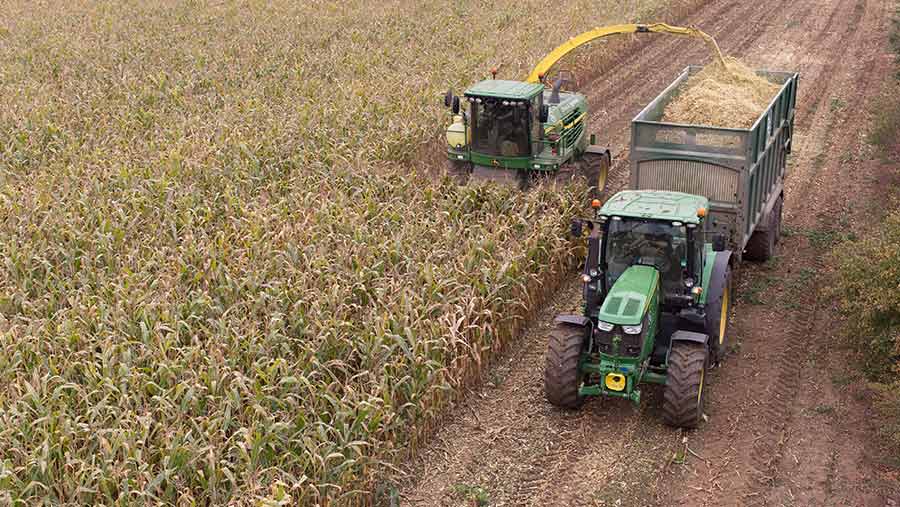Mixed weather at maize harvest prompts winter forage warning
 © Tim Scrivener
© Tim Scrivener Regular forage analysis and ration tweaks will be essential this winter after contrasting maize harvest conditions led to a wide variation in silage quality.
Many crops matured early in the dry, hot summer and were harvested in September, according to Liz Homer of Trouw Nutrition’s technical analysis department.
See also: Why drilling maize deeper and later could be future trend
But other farms were less fortunate and were caught by a wet start to October, resulting in some very mature crops put into clamps, Dr Homer said.
Results from the first 900 samples analysed by the company were likely to be from earlier harvested crops and had shown similar average dry matter levels to last year at 32.1%.
However, there is a considerable range:
- With varying crop maturity, both digestibility (D value) and energy (ME) are slightly lower than last year.
- Average starch is one percentage point down on 2019 at 30.1% but there is a large proportion of samples within the 30-35% starch range.
- Starch degradability and bypass starch are similar to last year, which should support milk production.
- Fibre levels – neutral detergent fibre (NDF), acid detergent fibre (ADF) and lignin – are all slightly increased, reflecting the digestibility of the crop.
But Dr Homer warned that it was probable late harvested crops would have lower digestibility than those taken in good time, presenting different feeding challenges.
“Earlier silage could feed well but later crops will potentially be less digestible and with reduced starch degradability, requiring very different supplementation,” she predicted.
“It will be crucial to get clamps analysed throughout the season so nutritionists know the quality of the forage available, to ensure diets are correctly balanced.”
Balancing forages
Consideration would also need to be given to the balance of forages in the diet, she added.
If maize was fed with lower-digestibility grass silages, then cereals may be needed to promote good rumen function, she explained.
Many grass silages had come back with lower crude protein levels, Trouw’s analysis revealed.
If these were fed with low-starch maize silage then supplementation with both cereals and additional protein would be needed, Dr Homer concluded.
Silage quality breakdown |
||
| Nutrients | Maize silage 2020 | Maize silage 2019 |
| Dry matter (%) | 32.1 | 32.6 |
| Crude protein (%DM) | 6.9 | 6.8 |
| D value (%) | 72.1 | 73.6 |
| ME (MJ/kg DM) | 11.3 | 11.6 |
| Starch (%DM) | 30.1 | 31.2 |
| Starch degradability (%) | 79.8 | 80.3 |
| Bypass starch (g/kg DM) | 60.4 | 60.4 |
| Ash (%DM) | 3.8 | 3.7 |
| NDF (%DM) | 37.7 | 36.6 |
| ADF (%DM) | 23.2 | 22 |
| Lignin (g/kg DM) | 23.4 | 21.5 |
| pH | 4 | 3.9 |
| Lactic acid (g/kg DM) | 51.9 | 50 |
| Rapidly fermentable carbohydrate (g/kg DM) | 219.9 | 226 |
| Total fermentable carbohydrate (g/kg DM) | 507.9 | 520 |
| DyNE (MJ/kg DM) | 6.73 | 6.9 |
